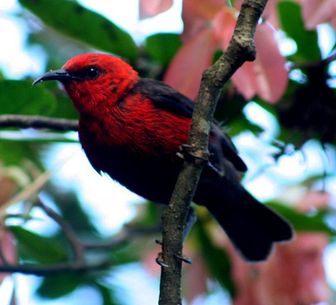Micronesian Myzomela
It is distributed throughout the Northern Mariana Islands, including Rota, Tinian and Saipan, as well as Yap, Chuuk, Pohnpei and Kosrae in Micronesia, and the islands of Palau. The species once also occurred in Guam, but that population is now almost certainly extinct.

Original source: Peter
Author: Peter
The Micronesian Myzomela is classified as Least Concern. Does not qualify for a more at risk category. Widespread and abundant taxa are included in this category.
The Micronesian Myzomela (left) is bright red with a fine, decurved bill; other species have various patterns of red, black, or red-and-black. Five species of honeyeater actually reached Hawaii, but all are now extinct (and none are included in the totals above). The last to survive was Kauai Oo Moho braccatus. The last vocalizing male was heard in 1987. In Australia, honeyeaters are major pollinators of many endemic plants. More
The Micronesian Myzomela (Myzomela rubratra) is a species of bird in the honeyeater family Meliphagidae. The species forms a superspeices wit a number of related and similar looking island and mainland myzomelas across the Pacific and Australasia. It in turn is composed of seven insular subspecies. It is distributed throughout the Northern Mariana Islands, including Rota, Tinian and Saipan, as well as Yap, Chuuk, Pohnpei and Kosrae in Micronesia, and the islands of Palau. More
Myzomela rubratra Micronesian Myzomela Myzomela cardinalis Cardinal Myzomela Myzomela ... http://en.wikipedia. More
everywhere, as were Micronesian Myzomela and flocks of Chestnut Mannikins. I saw small numbers (1-3) of Nicobar Pigeons fly over shortly after dawn each morning, and found dozens of Rufous Night-Herons frequenting the landfill at M dock. While out diving each day I had good opportunities to see near-shore seabirds. Black Noddies and Black-naped Terns were especially common, often forming large feeding flocks, and I also saw a few Brown Noddies, Bridled, Sooty and Great Crested Terns, and White-tailed Tropicbird. More
Family : Meliphagidae
Genus : Myzomela
Species : rubratra
Authority : (Lesson, 1827)
